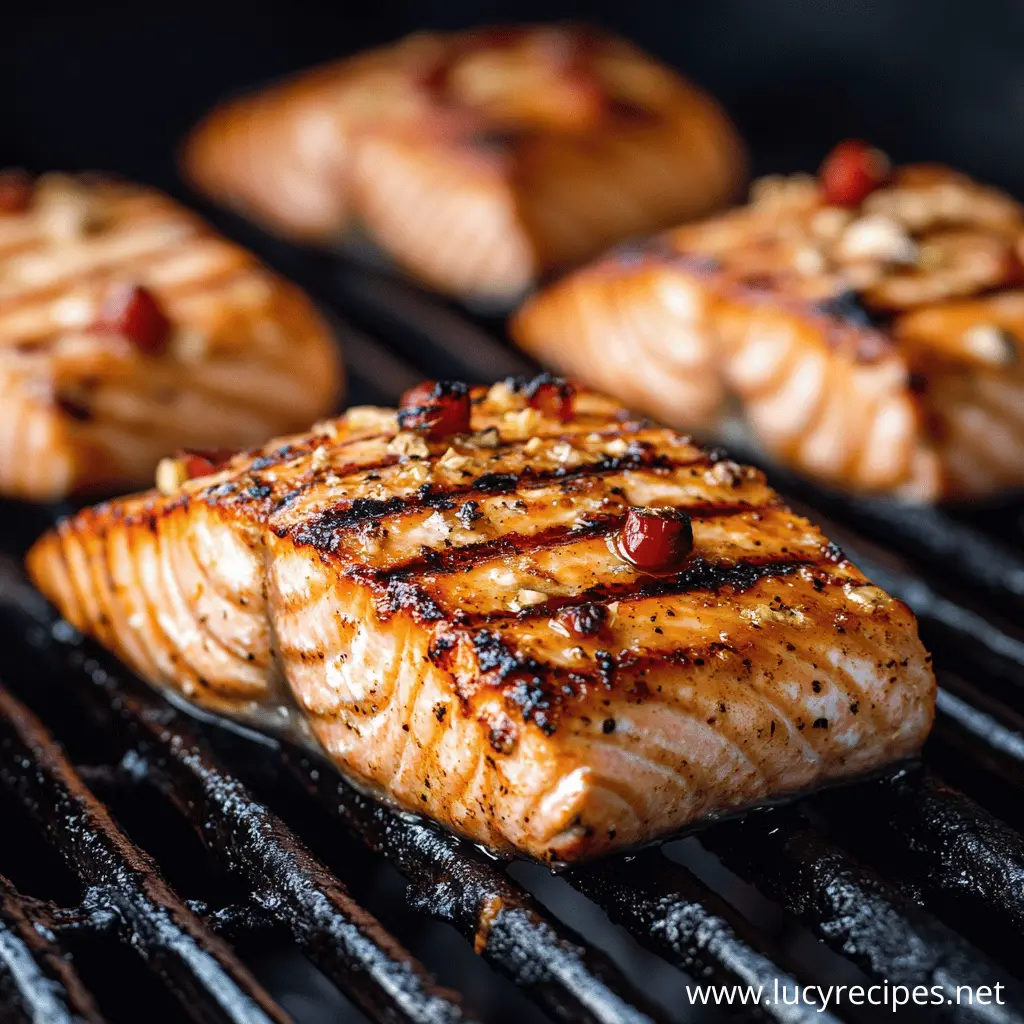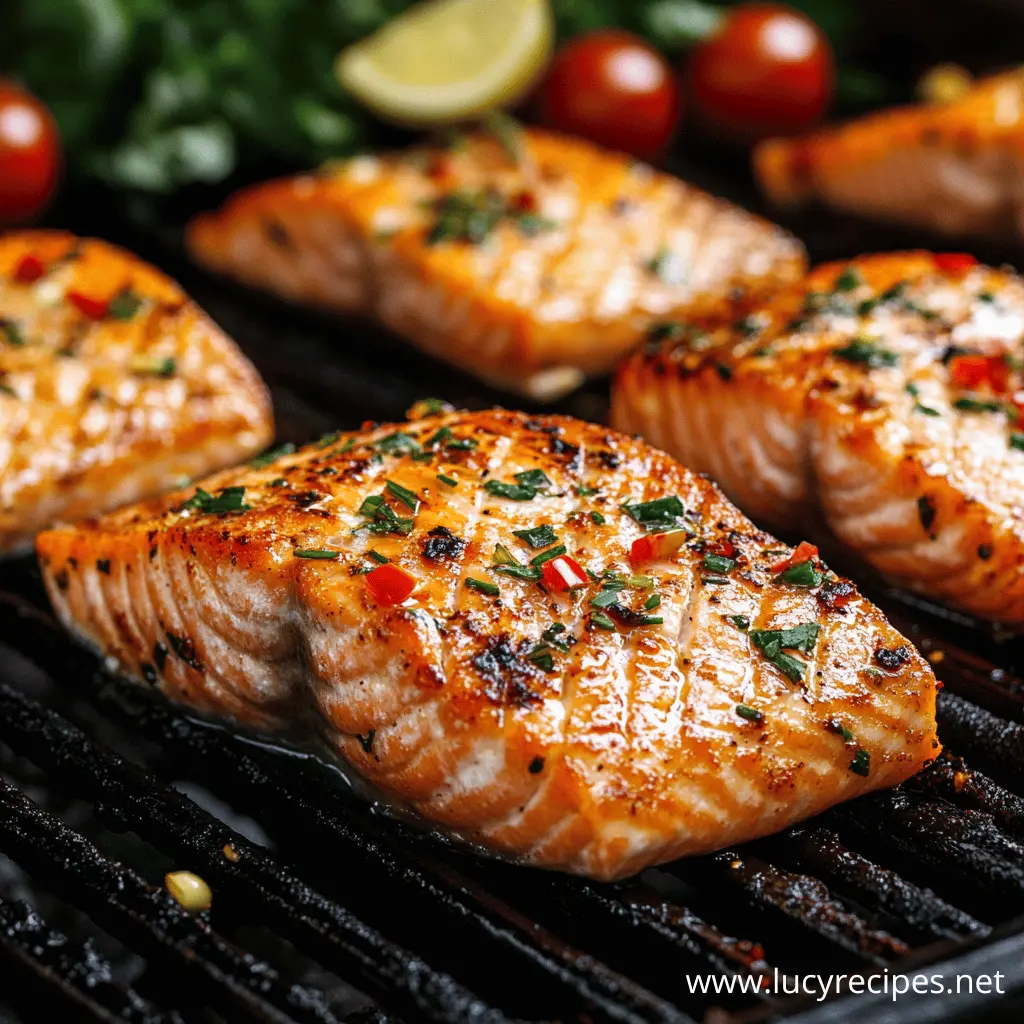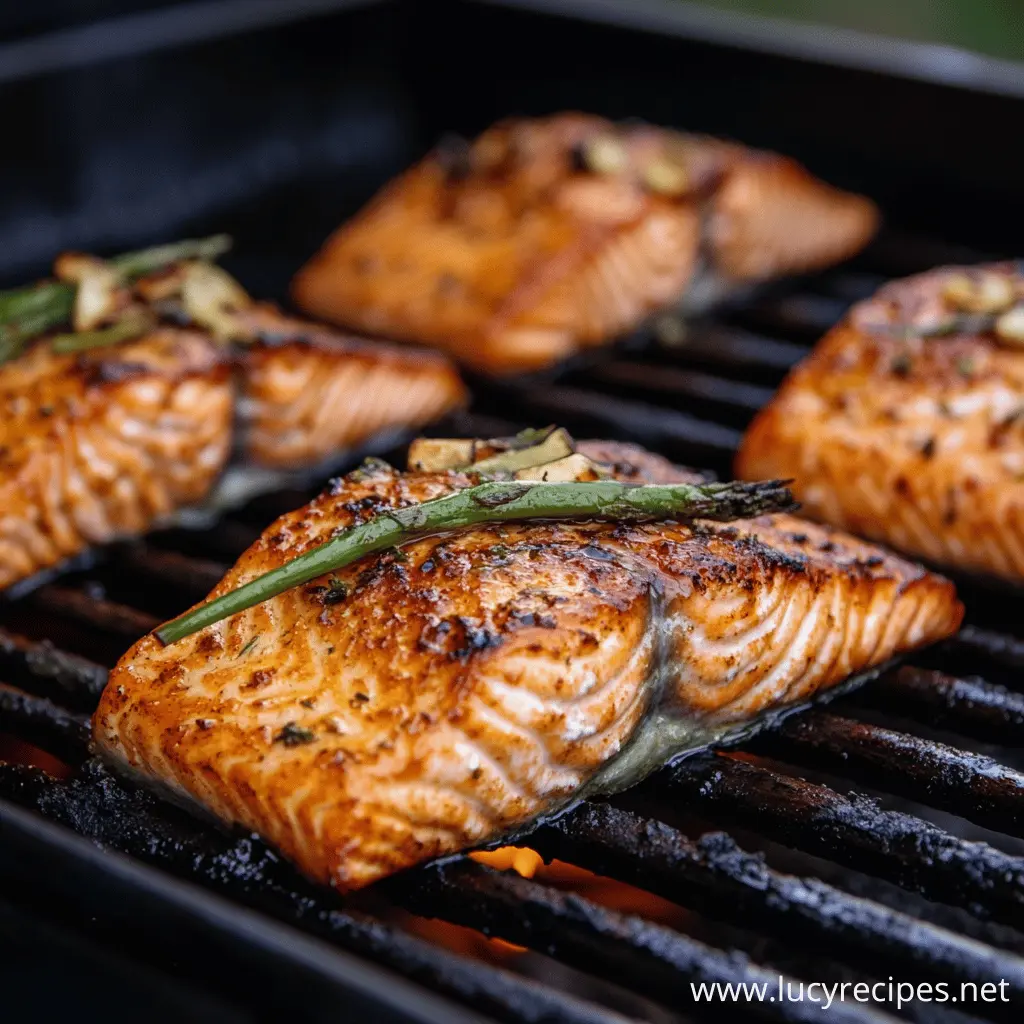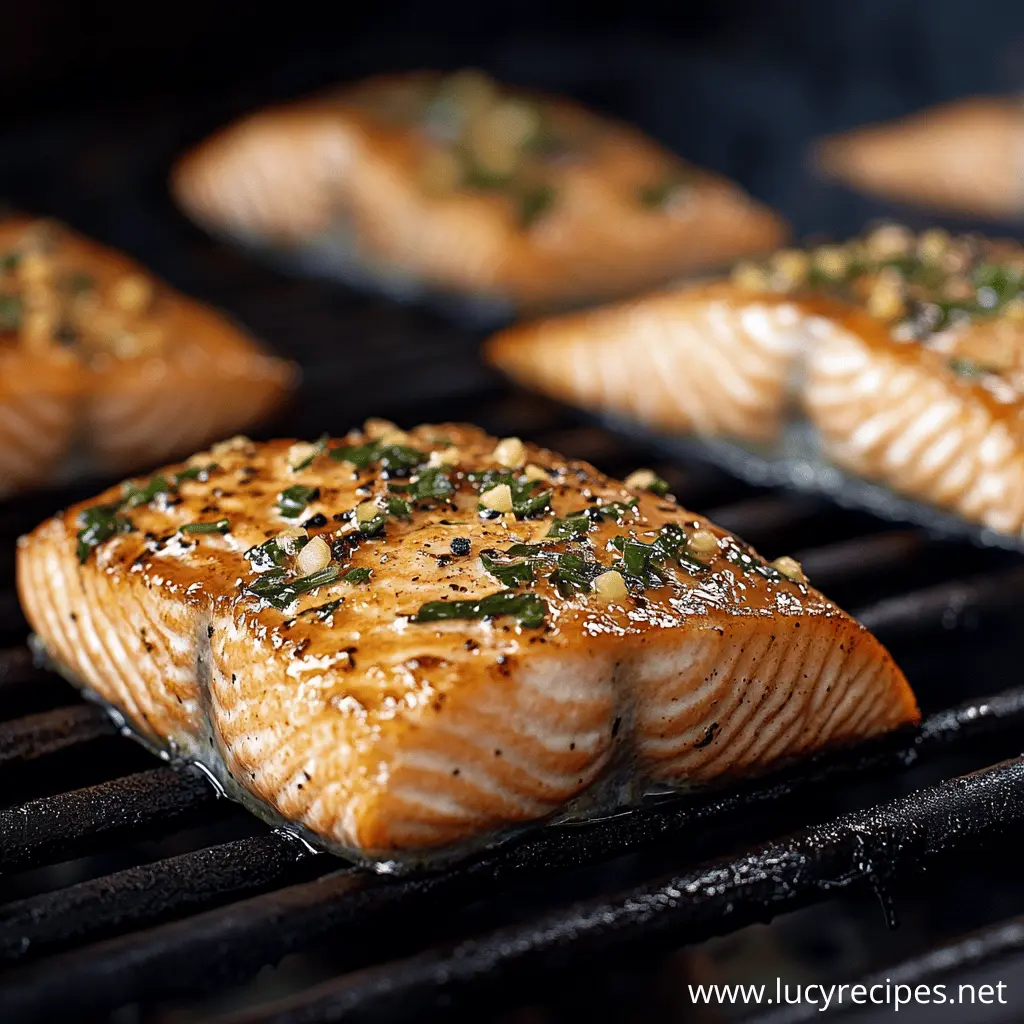Introduction
Grilling salmon is a rewarding culinary art that combines precision, technique, and flavor mastery. Whether you are preparing dinner for your family or hosting an outdoor BBQ, knowing how to grill salmon correctly is vital. This guide explores every detail, focusing on how long to grill 1 inch salmon, so you can achieve perfectly cooked fish every time. From understanding salmon thickness to choosing the best grilling methods, you will find all the tips and techniques you need for success.
Table of Contents
Understanding Salmon Thickness
Thickness matters when grilling salmon because it directly influences the cooking time and method. If you’re wondering How Long To Grill 1 Inch Salmon, a 1-inch fillet is the standard thickness often found at markets, making it an excellent starting point for mastering grilling techniques.
For additional ideas on grilling techniques, check out grilling salmon in foil, which is an excellent alternative for locking in moisture and flavor.
Key Considerations for Salmon Thickness:
- Thicker Fillets: Fillets over 1 inch require longer cooking times and may benefit from indirect grilling methods to prevent burning the exterior.
- Thinner Fillets: These cook faster, typically within minutes, and require lower heat to prevent them from drying out.
- Uniform Thickness: Aim for fillets with consistent thickness for even cooking.
By measuring your salmon’s thickness and understanding How Long To Grill 1 Inch Salmon, you can achieve perfectly grilled fillets every time.
Preparing Salmon for Grilling
Proper preparation is a crucial step when determining How Long To Grill 1 Inch Salmon and ensuring delicious results. Before placing your salmon on the grill, follow these essential steps to enhance flavor and prevent sticking.
Steps to Prepare Salmon:
- Clean and Pat Dry: Rinse your salmon under cold water to remove any debris or scales. Use a clean paper towel to pat it dry, ensuring the marinade adheres well.
- Remove Pin Bones: Using tweezers, remove any visible pin bones to enhance the eating experience.
- Seasoning: Create a flavorful marinade or dry rub. Common choices include olive oil, lemon juice, garlic, fresh herbs like dill, and a pinch of salt and pepper.
- Let It Rest: Allow the salmon to rest at room temperature for 15-20 minutes to ensure even cooking.
- Prepare the Grill: Clean the grill grates thoroughly and coat them with a thin layer of oil to prevent sticking.
By properly preparing your salmon and understanding How Long To Grill 1 Inch Salmon, you can transform it into a perfectly cooked, flavorful dish.
Looking for inspiration for side dishes? Pair your grilled salmon with recipes like old-fashioned sweet potato casserole for a perfect holiday or BBQ meal.
Grilling Methods for Salmon
Different grilling methods offer unique results. Choose the one that best suits your equipment and the flavor profile you’re aiming for. Explore the benefits of indirect grilling or plank grilling with tips found in the guide to foil grilling salmon.
Common Grilling Methods:
- Direct Heat: Place the salmon directly over medium heat. This method works well for thinner fillets and provides a slightly charred, crispy exterior.
- Indirect Heat: For fillets over 1 inch thick, place the salmon away from the direct flame. This method cooks the fish more gently, ensuring it remains moist.
- Plank Grilling: Using a cedar plank adds a smoky, woody flavor. Soak the plank in water for at least an hour before use to prevent burning.
- Foil Wrapping: Wrap the salmon in aluminum foil with seasonings. This method locks in moisture and reduces the risk of overcooking.
Experimenting with these techniques will help you discover your preferred method for grilling salmon.
Ideal Grill Temperature for Salmon

Temperature control is crucial when grilling salmon. An improperly heated grill can ruin your fish—too low and it may stick; too high and it may burn.
Recommended Grill Temperatures:
- Preheating: Always preheat your grill to 375°F to 400°F. Medium heat provides the best balance for cooking salmon evenly.
- Using a Thermometer: Use a grill thermometer to monitor the temperature and maintain consistency.
- Avoiding Fluctuations: Keep the lid closed as much as possible to retain heat and reduce cooking time.
Consistency in temperature ensures even cooking, locking in moisture while creating a crispy, flavorful crust.
How Long to Grill 1 Inch Salmon?
Grilling a 1-inch salmon fillet is straightforward when you follow the correct timing guidelines. The general rule is:
- Direct Heat: Grill for 4-6 minutes per side.
- Internal Temperature: Aim for an internal temperature of 145°F at the thickest part of the fillet.
Tips for Timing:
- Use a Timer: Set a timer to avoid overcooking. Even 1-2 extra minutes can dry out your salmon.
- Check the Thickness: Slightly thicker areas may require an additional 1-2 minutes.
- Flip Gently: Use a wide spatula to turn the salmon without tearing it.
When wondering “how long to grill 1 inch salmon?”, always consider the type of grill and its heat distribution. Checking the internal temperature ensures a perfect result every time.
For alternative seafood ideas, see the recipe for mini pecan tarts as a dessert option to complement your grilled salmon feast.
Using a Meat Thermometer
A meat thermometer is a foolproof tool to ensure your salmon is cooked to perfection. It eliminates the guesswork and guarantees food safety.
How to Use a Meat Thermometer:
- Insert Properly: Place the thermometer into the thickest part of the fillet, avoiding the grill grates or bones.
- Check for 140°F: Remove the salmon when it reaches this temperature, as residual heat will bring it up to the recommended 145°F while resting.
- Calibrate Regularly: Ensure your thermometer is accurate by testing it in boiling water (212°F).
Using a thermometer simplifies the process and delivers consistently excellent results.
Signs of Perfectly Grilled Salmon

Knowing when your salmon is perfectly grilled requires attention to visual and textural cues. These indicators help ensure your fish is not undercooked or overdone.
Key Signs:
- Opaque Color: The flesh should change from translucent to opaque and have a soft pink hue.
- Flaky Texture: Use a fork to check if the salmon flakes easily but holds together.
- Juicy Appearance: Well-grilled salmon should appear moist, not dry, with a firm texture.
Mastering these cues will give you confidence every time you grill.
Common Grilling Mistakes to Avoid
Avoiding common pitfalls can make or break your salmon grilling experience. Here are some frequent mistakes and how to avoid them:
- Skipping Preheating: A cold grill causes uneven cooking and sticking.
- Overcooking: Monitor closely to avoid drying out the fish.
- Insufficient Seasoning: Enhance flavor by using bold marinades or rubs.
- High Heat: Excessive heat can burn the exterior before the interior cooks fully.
By avoiding these mistakes, you can ensure a stress-free and enjoyable grilling process.
Grilling with Skin On vs. Skin Off
The decision to grill salmon with or without the skin depends on your personal preference and desired texture.
Benefits of Skin-On Grilling:
- Acts as a protective barrier, preventing sticking.
- Adds a crispy texture when seared.
- Locks in moisture and enhances flavor.
Benefits of Skin-Off Grilling:
- Easier to season the entire fillet.
- Preferred for those who don’t enjoy the texture of fish skin.
Experimenting with both methods allows you to determine which suits your taste best.
Grilling Frozen vs. Fresh Salmon
Grilling frozen salmon is possible but requires additional steps:
- Fresh Salmon: Provides optimal flavor and texture, requiring less preparation time.
- Frozen Salmon: Grill directly from frozen by adding 50% more cooking time. Ensure it reaches an internal temperature of 145°F.
Both fresh and frozen options can yield delicious results when cooked properly.
Pairing Grilled Salmon with Sides
Complement your salmon with a variety of sides to create a balanced and flavorful meal.
Popular Pairings:
- Vegetables: Grilled asparagus, roasted Brussels sprouts, or a fresh green salad.
- Starches: Wild rice, quinoa, or buttery mashed potatoes.
- Sauces: Lemon-dill butter, tzatziki, or a tangy mango salsa.
Pairing thoughtfully enhances your meal’s overall appeal and flavor harmony.
Health Benefits of Grilled Salmon
Salmon is not only delicious but also packed with nutrients. Here’s why it’s a great choice:
- Omega-3 Fatty Acids: Supports heart health and reduces inflammation.
- High Protein Content: Essential for muscle repair and growth.
- Vitamins and Minerals: Rich in vitamin D, selenium, and potassium, which support overall health.
Grilling salmon is one of the healthiest ways to prepare it, retaining nutrients without adding unnecessary fats.
Grilling Variations Across Cuisines

Grilled salmon takes on unique flavors depending on the culinary traditions it’s prepared in. Explore these global inspirations:
- Asian: Teriyaki-glazed salmon with ginger and soy sauce.
- Mediterranean: Lemon, olive oil, and oregano.
- Latin American: Chili-lime rub with fresh cilantro.
- American: Smoky BBQ sauce or a brown sugar rub.
Trying different styles allows you to enjoy salmon in exciting and diverse ways.
Tips for Grilling Salmon Without a Grill
No grill? No problem! These alternatives yield similar results:
- Oven Broiling: Place salmon on a baking sheet and broil for 6-8 minutes.
- Stovetop Grill Pan: Mimics grill marks and adds a caramelized crust.
- Air Fryer: Cook at 375°F for 10-12 minutes for a crispy exterior.
These methods ensure you can enjoy perfectly cooked salmon without outdoor grilling equipment.
FAQs
How Long to Grill 1 Inch Salmon?
Grill for 4-6 minutes per side on medium heat. Always use a thermometer to confirm doneness.
Can You Grill Salmon on Aluminum Foil?
Yes, foil prevents sticking and simplifies cleanup.
What Seasonings Work Best for Grilled Salmon?
Salt, pepper, garlic powder, dill, and paprika are popular choices.
Conclusion
Grilling salmon is an enjoyable and rewarding process that combines flavor, health benefits, and versatility. By understanding how long to grill 1 inch salmon and following the techniques outlined in this guide, you can consistently achieve delicious results. Whether you’re preparing a simple dinner or hosting a barbecue, perfectly grilled salmon is sure to impress. Happy grilling!

